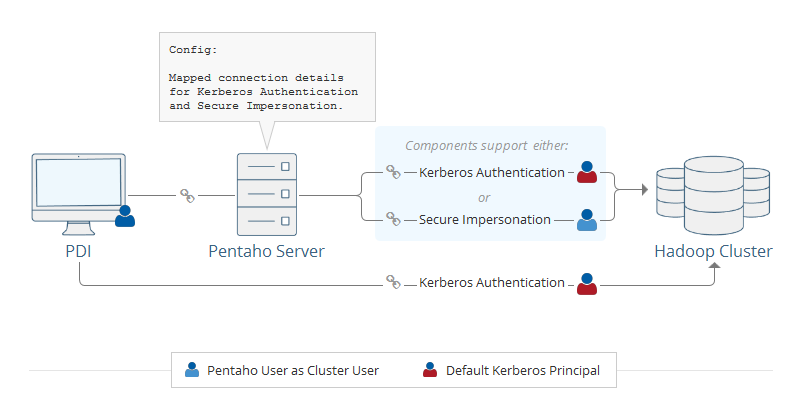Big data security
The security and protection of sensitive data is a major concern of data management today. To assist users in protecting their data, Pentaho provides two methods of implementing security for the Pentaho Server: Kerberos authentication and secure impersonation. Both methods are secure, and require a user to provide proof of identity to securely connect to a cluster.
Kerberos authentication versus secure impersonation
Kerberos authentication occurs when Pentaho users connect to a Hadoop cluster with a default Kerberos principal. All the Pentaho users connect to the Hadoop cluster with the same Kerberos principal.
In secure impersonation, users connect to the Hadoop cluster as a proxy user. The Pentaho user ID matches the cluster user ID in a one-on-one mapping, and resources are accessed and processes are executed as the cluster user.
Secure impersonation occurs when:
- pre-defined credentials authenticate to a Kerberos server before connecting to the Hadoop cluster,
- the Pentaho Server is configured for secure impersonation, and
- the Hadoop cluster is secured.
Prerequisites
For secure impersonation to work, the following conditions must be met:
- The Hadoop cluster must be configured with Kerberos security.
- The Hadoop cluster must have a Kerberos principal that represents Pentaho that can authenticate to the cluster services and have privileges to impersonate.
- Job or transformation requests must come from the Pentaho Server to the cluster to use secure impersonation.
- The Hadoop components must support secure impersonation.
Pentaho support for secure impersonation is determined by whether the Hadoop components support secure impersonation. If the Hadoop component does not support secure impersonation, then Kerberos authentication is used.
Supported components
These components are currently only supported for secure impersonation on Cloudera 5.7 or greater.
| Component | Secure Impersonation Support? |
| Cloudera-Impala | Yes |
| HBase | Yes |
| HDFS | Yes |
| Hadoop MapReduce | Yes |
| Hive | Yes |
| Oozie | Yes |
| Pentaho MapReduce (PMR) NoteWhen running a Pentaho Map Reduce job,
you can securely connect to Hive and HBase within the mapper, reducer or
combiner. | Yes |
| Pig Executor | Yes |
| Carte on Yarn | No |
| Impala | No |
| Sqoop | No |
| Spark SQL | No |
Secure impersonation directly from the following is not supported:
- PDI client
- Scheduled Jobs and Transformations
- Pentaho Report Designer
- Pentaho Metadata Editor
- Kitchen
- Pan
- Carte
When you run a transformation or job to run against the cluster from the PDI client, you cannot use secure impersonation. However, if you execute that job or transformation you created in the PDI client from the Pentaho Server, then you can use secure impersonation.
How to enable secure impersonation
Here is how to enable secure impersonation and how the Pentaho Server processes that request. The
mapping value simple in the shim configuration file turns on the secure
impersonation. You can use secure impersonation with Cloudera and Hortonworks
clusters
Understanding secure impersonation
When the Pentaho Server starts, it verifies the mapping type value in the configuration file. If the value is disabled or blank, then the server does not use authentication when connecting to the Hadoop cluster. The Pentaho Server cannot log onto a secured cluster if the value is set to disabled or blank. If the value is simple, then requests are evaluated for origination from the PDI client tool (Spoon) or from the Pentaho Server. If the request comes from a client tool, then Kerberos authentication is used; if the request comes from the Pentaho Server, then the request is evaluated to see whether the service component supports secure impersonation. If the component does not support secure impersonation, the request uses Kerberos authentication. If the component supports secure impersonation, then the request will use secure impersonation.
When impersonation is successful, the Pentaho Server log will report

Use secure impersonation with Cloudera
Set up secure impersonation for your Pentaho Server to access a Cloudera cluster.
Use secure impersonation with Hortonworks
Set up secure impersonation for your Pentaho Server to access a HortonWorks cluster.
How to enable Kerberos authentication
The following articles explain how to use Kerberos with different components.
Set up Kerberos for Pentaho
Set up Kerberos for Pentaho to connect to a secure Big Data cluster.
Use Kerberos with MapR
Configure Kerberos authentication to access MapR cluster components.
Use Kerberos with MongoDB
Configure Kerberos authentication to access MongoDB.
Use Kerberos with Spark Submit
Execute Spark Submit jobs on secure Cloudera Hadoop clusters.
Use Knox to access Hortonworks
Set up Pentaho to use Knox for accessing Hortonworks cluster components.

